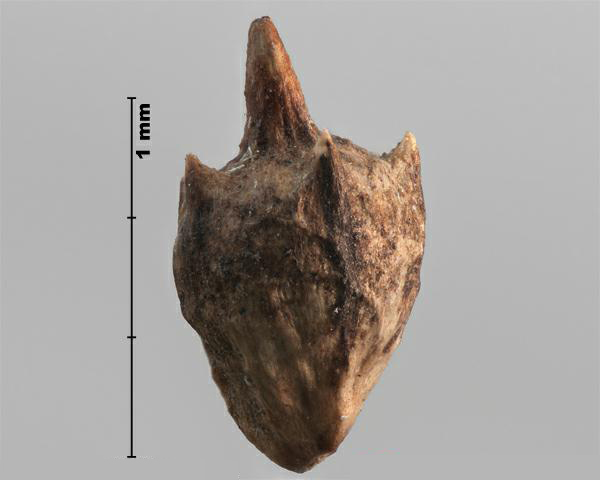Family
Asteraceae
Common Name
Common ragweed
Regulation
Secondary Noxious, Class 3 in the Canadian Weed Seeds Order, 2016 under the Seeds Act.
Distribution
Canadian: Occurs across Canada except in NU and YT (Brouillet et al. 2016Footnote 1).
Worldwide: Native to North and South America, and widely introduced elsewhere including Europe, Africa, temperate and tropical Asia, Australasia and the Pacific Islands (USDA-ARS 2016Footnote 2). Widely distributed in North America with both native and introduced populations present in the U.S. and Canada (Brouillet et al. 2016Footnote 1, USDA-NRCS 2016Footnote 3).
Duration of life cycle
Annual
Seed or fruit type
Achene within a bur
Identification features
Size
- Bur length: 1.9 - 3.7 mm
- Bur width: 1.5 - 2.8 mm
- Achene length: 1.5 - 3.0 mm
- Achene width: 1.5 mm
Shape
- Bur and achene are obovate
Surface Texture
- Bur is dull, woody
Colour
- Bur is dark grey with purple streaks
- Achene is brown
Other Features
- Bur has a ring of several spines near top approximately 0.5 mm long and an apical spine approximately 1.5 mm long
Habitat and Crop Association
Cultivated fields, fencerows, pastures, shores, canals, quarries, railway lines, roadsides, wasteland and disturbed areas (FNA 1993+Footnote 4, Darbyshire 2003Footnote 5, CABI 2016Footnote 6). Found in a range of both agronomic and horticultural crops, particularly in cereals and cultivated row crops (Basset and Crompton 1975Footnote 7, CABI 2016Footnote 6). Often present as a dominant species in early succession of uncultivated areas (CABI 2016Footnote 6).
General Information
Seeds of common ragweed are commonly found in stored and transported grains, and have been dispersed around the world as contaminants in seed and grain crops, including cereals, oilseeds and bird seed.
A single plant typically produces 3,000 - 4000 seeds, although up to 32,000 seeds per plant have been reported. Seeds remain viable for up to 40 years (CABI 2016Footnote 6).
Similar species
Perennial ragweed (Ambrosia psilostachya)
- Perennial ragweed burs are a similar size, obovate shape and grey colour as common ragweed.
- Perennial ragweed burs have smaller spines, or only an apical spine that may be broken off, and may lack the purple streaks of common ragweed burs.
- If the burs are removed, it is difficult to distinguish between common and perennial ragweed achenes.
Photos




Similar species


